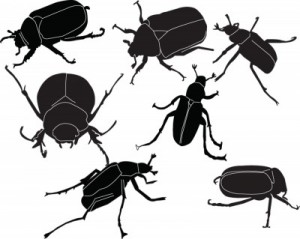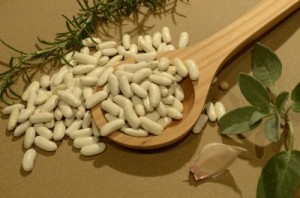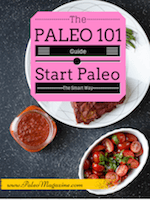Lectins – Are Your Food and Diet at Risk?
 Please raise your hand if you’ve got a passion for learning about lectins…
Please raise your hand if you’ve got a passion for learning about lectins…
Anyone?
Let’s be honest – lectins are not a particularly popular topic. We read a lot more about gluten, toxic metals, and genetically modified foods.
Many health experts, however, are ardently opposed to lectins.
Why, you ask?
Well, it’s not always clear. Mark Sisson put together a good article about lectins, but I thought I’d give a bit more thorough round-up of the literature on lectins.
So What are Lectins?
Lectins are a group of proteins.
In general, there are 12 major lectins, although there are actually quite a few more (about 119 known types total). I’ll talk about a few particular lectins below, but for the most part, it’s enough to know that lectins are a group of proteins.
Where Do Lectins Come From?
 Lectins exist in a wide variety of foods, but they’re generally prevalent in much larger quantities in plants than in animals. All in all, some studies show that lectins exist in at least 30% of all foods as eaten.
Lectins exist in a wide variety of foods, but they’re generally prevalent in much larger quantities in plants than in animals. All in all, some studies show that lectins exist in at least 30% of all foods as eaten.
Toward the bottom of this article, I’ve included a section on which foods contain the “worst” lectins (i.e., the lectins that are mostly likely to cause health problems for humans).
A few lectins are also produced by humans. For instance, you might have heard of Mannose-binding lectins. Mannose-binding lectins (also known as mannan-binding proteins) are produced by the human liver to help identify and fight against bacteria, viruses, and other foreign invaders.
What Do Lectins Do?
There are a lot of different and obscure reasons that plants and animals produce lectins, and for our purposes, we don’t really need to know most of the functions of lectins.
 In plants, however, there is one very important function that lectins perform: Lectins act as a natural pesticide.
In plants, however, there is one very important function that lectins perform: Lectins act as a natural pesticide.
Plants don’t generally want to be eaten and digested – especially the seeds that help the plant reproduce. Lectins help many plants keep from being eaten and digested by making any animal that eats the plant (particularly the seeds) get sick and/or not be able to properly digest the seeds.
In this way, lectins deter animals from eating the plant, and if the animal does so anyway, it’ll likely poop out the seed without digesting it.
Plant – 1.
Animal – 0.
Are All Lectins the Same?
No.
All lectins are similar, but they’re not exactly the same. One of the things that makes all lectins similar is that they all like to bind to sugar molecules.
The difference, though, is that different lectins like to bind to different types of sugar molecules. And this is a very important distinction when we think about how certain lectins might affect our health.
For instance, Wheat Germ Agglutinin (“WGA“) is a specific type of lectin found in wheat. WGA likes to bind to 2 particular carbohydrates: N-Acetyl Glucosamine (“NAG“) and N-Acetylneuraminic acid.
When I talk below about the ways that lectins can affect our health, it will be important to remember that WGA likes to bind to NAG. (It’s a slight misspelling, but “WAG likes NAG”).
What are the Problems with Lectins?
This is the question that you’ve been waiting for, right?
What can lectins do to you? And does it matter?
Remember how WGA (one form of lectin) likes to bind to NAG (a sugar)?
Well, here’s an interesting fact: The cells of our intestines are lined with NAG. (This is a bit of oversimplification, but still pretty accurate.)
That means that WGA (a lectin) likes to bind to the cells of our intestines. And this is not a good thing:
- WGA damages our intestinal walls and causes inflammation when it binds to the cells of our intestines. (See here and here). By binding to the cells in our intestines, WGA thickens our intestinal walls and causes our intestines to not be able to properly absorb nutrients. Binding to intestinal cells also triggers an immune response in our bodies that causes our intestinal walls to get inflamed much like a rash might swell up on your arm if you scratch it.
- Moreover, some of the tiny WGA particles get through our intestinal lining (and into our blood stream) by tricking our intestinal cells into believing that the WGA is actually something else. This alone can cause damage to the cellular lining of our intestines, but it also causes further damage once it’s gotten into our bloodstream.For instance, once WGA gets into the blood, it can stop some important brain functions, it can lead to both insulin resistance and leptin resistance, and it can lead to a ton of other problems, like arthritis, ulcers, and maybe even diabetes.
So Every Lectin Does These Terrible Things?
No. Many lectins have almost no effect on someone who is healthy.
For instance, most people can eat raw tomatoes without any problem. And yet, raw tomatoes have a lot of lectins in them.
I’ve been using WGA as an example of a “bad” lectin, but WGA is not the only lectin that likes to bind to NAG, nor is NAG the only sugar in our bodies.
Many of the bad lectins fall into a group known as “Chitin-Binding Lectins.” A chitin is a long chain of NAG (N-Acetyl Glucosamine), which is the sugar molecule that is preferentially bound by WGA (and a few other lectins).
The lectins in potatoes, tomatoes, barley, and rice also bind to chitins.
WGA is a form of lectin that is better researched and documented, but that doesn’t mean that other lectins can’t cause similar problems. In fact, cells of our intestines are affected by quite a few lectins.
The takeaway is that some lectins are very bad, and some lectins have almost no effect on us.
What Foods contain the Worst Lectins?
The worst lectins are found in the following foods:
- Grains (wheat, quinoa, oats, buckwheat, rye, barley, millet, corn, and possibly rice, although most of the lectins in rice are not in the part that gets eaten)
- Legumes (any kind of bean plus peanuts, which have a particularly bad lectin)
- Soy

It’s long been known that certain foods like Kidney Beans and Castor Beans contain especially toxic lectins. In fact, the lectin Ricin, which is found in Castor Beans, is so toxic that it’s used as a weapon in biochemical warfare.
Fortunately, soaking and cooking something like Kidney Beans will destroy enough of the lectins to keep them from killing us. I’ll talk below about whether that means we should keep eating them.
The following food groups aren’t as bad, but they also contain potentially problematic lectins:
- Dairy
- Nightshades (potato, tomato, eggplant, pepper, and cucumber)
- Nuts and Seeds
These foods often don’t cause quite as many problems for people, but they’re something to be careful with.
Dairy, in particular, is a group of foods that isn’t usually associated with lectins, but the lectins in milk are actually “designed” by nature to cause leaky gut, since infants who are drinking milk actually need to get a mother’s hormones and antibodies directly into their bloodstream in order to develop their immune system (thanks to Sarah (The Paleo Mom) for pointing this out).
One other group of foods to be especially careful with is Genetically Modified foods. Many GMO foods have lectins spliced into them as part of their manufacturing process, and the toxicity and resistance to heat of the lectins in GMO foods is relatively untested and unknown.
Don’t Our Bodies Break Down Lectins Before They Hurt Us?
No. Neither our small intestines nor the bacteria in our guts can generally break down lectins.
What About Cooking?
 Excellent question. Many lectins are broken down by heat, but this is not true for all lectins. And it matters what type of heat (wet or dry) and how high.
Excellent question. Many lectins are broken down by heat, but this is not true for all lectins. And it matters what type of heat (wet or dry) and how high.
Some lectins – such as those found in peanuts, carrots, wheat, maize, and other grains – are more resistant to heat. WGA has long been known to be more heat-resistant than other lectins ( Aub JC et al. Proc. Natl. Acad. Sci USA 1963; 50: 613-19).
Remember, though, that some lectins are not as toxic as others. So, for instance, although lectins in carrots may not break down as easily when they’re cooked, that doesn’t mean that they’re anywhere near as bad for us as the lectins in many legumes and grains.
The biggest problem is that there is little evidence to show that cooking completely removes all of the toxic lectins from food, as there isn’t a ton of testing data floating around.
Apart from cooking, sprouting can also reduce the amount of lectins in a food (Lis H. et al. In The Biochemistry of Plant Lectins, Vol. VI, NY Academic Press, 1981).
Why Isn’t Damage by Lectins Diagnosed by Doctors?
In general, the damage done by lectins like WGA is hard to diagnose, because of the type of harm done. Lectins don’t usually cause the production of antibodies or allergic reactions, so testing won’t usually detect the damage (for instance to the cell lining of the intestines).
So How Big of a Problem is this Really?
I’ve drawn a pretty dire picture of lectins.
 It may be surprising, then, to hear me say that I don’t think lectins are something that most people need to worry about.
It may be surprising, then, to hear me say that I don’t think lectins are something that most people need to worry about.
Although very little good that comes from eating lots of lectins, if you cook your food, then most lectins will be deactivated (a fancy way of saying they won’t hurt you).
With that in mind, part of the reason that I don’t think lectins are a huge concern is because I think that if you actually want to get healthy, you should already be avoiding the foods with the worst lectins, such as grains, legumes, and soy. It’s just that there are much better reasons than lectins to stop eating grains, legumes, and soy.
What Should I Do To Make Sure Lectins Aren’t Destroying My Health?
- Stop eating stuff that isn’t good for you anyway.Ditch the grains.
Forget about legumes.
Stop eating Soy.None of these foods are good for you anyway. They’re generally low in vitamins and minerals, they contain a lot of phytates that prevent you from absorbing many minerals, and they are mostly empty calories that will send you on a roller-coaster ride of hormones.As I mentioned above, lectins are another possible reason to avoid grains, legumes, and soy, but they’re not the biggest reason. - If you’re not willing to stop eating ALL grains, legumes, and soy, at least give up wheat and peanuts. There’s no doubt that lectins from wheat and peanuts will eventually cause health problems for pretty much everyone.
- Experiment with Dairy, Nightshades, and Nuts if You have Stomach Issues. There’s a chance – particularly if you have stomach issues – that you react to the lectins in foods like dairy, nightshades, and even nuts.If you’ve gotten rid of grains, legumes, and soy, but you’re still having stomach problems, then take out the dairy for a while. After a few weeks, have some dairy again and see how it effects you.If you add something like dairy or nightshades back into your diet and it feels wrong, then it may be the lectins or it may be something else in that food, but you’ll know that you shouldn’t eat that food.
- Cook your food.This is an easy one, since you probably already do it, but try to cook most things you eat. Some raw vegetables are OK, but cooking generally makes foods much more digestible.
- Start listening.This is a tough one at first, but the answer in the end is to start listening to your body. Notice how you react when you eat certain things. Often this requires experimenting and taking out a group of foods for 30 or 60 days. It’s a pretty simple solution, but I never promised an easy one.
What Do You Think?
Are lectins something that you’re very concerned about? Why or why not? Please let me know in the comments!
Photos courtesy of keng88, Primoz Jenko (123RF), Vukasin Ilic (123RF), Maurizio Martini (123RF), Vadym Zaitsev (123RF), and Matthew Benoit (123RF).

